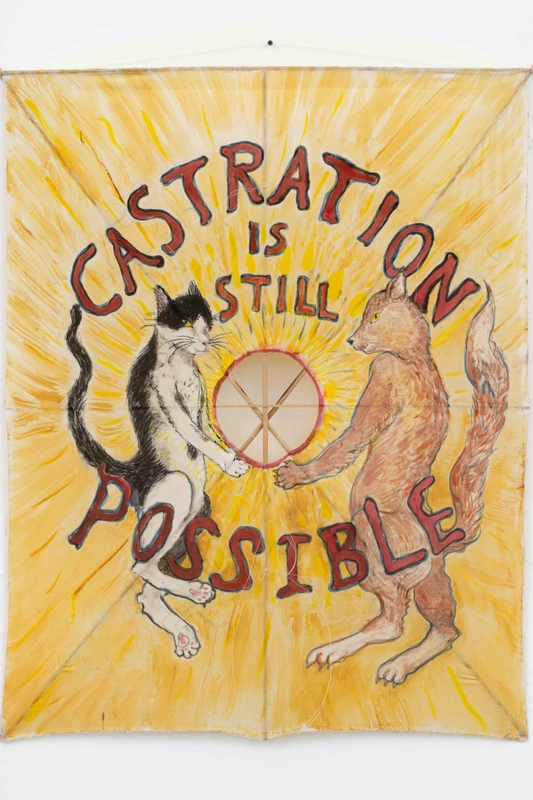Candice Lin / The Animal Husband
16 Mar-1 Jun 2024


In her first solo exhibition in Scotland, Candice Lin brings together new and existing work to play with the University of Edinburgh’s former Natural History Museum as a site of corrupted encounters, transgressions and transformations. Queering human and animal relationships, Lin uses a vocabulary of crude, ambiguous and dreamlike imagery to expose the conceits surrounding the scientific categorisation and control of bodies, and its links to the construction of race, gender, animality and humanness.
The ceramic sculpture Piss Protection Demon will greet visitors with the smell of wolf urine, what merchants describe as “territorial deception scent” used to ward off so-called pest-animals or provoke the curiosity of other predators. Examining narratives of dominance, wildness and masculinity, its cat body, human ears and an inverted wolf skull speak of possible metamorphoses, trans-species projections and desires. In the centre of the gallery, a kinetic screen showcases a new video featuring an animated version of the artist’s cat, Roger, who philosophically ruminates on his relationship to Lin, the flesh lump that lives with him. He alludes to Thomas Granger, the first juvenile executed in the Plymouth Colony, during the early colonization of America. Roger narrates how Granger was given a death penalty for sex with animals and talks vividly about his own experience of castration, the draining of his ball juice being – as he puts it – and an “inevitable trading of power.” This links to Lin’s interest in Howard Chiang’s study of eunuchs, where Western sexologists condemned what English soldier George Carter Stent (1833– 1884) called in his influential but questionable account, the “unnatural proceedings” of castration. A cicatrix, the scar left after the removal of the penis, becomes a motif throughout the space: a symbol reappropriated from Western medical sources which sensationalized the practice as emasculating and debasing
A new series of intimate pewter sculptures hang from metal human-sized collars, suggesting non-normative reversals in the relationship between companion animals and their owners. The cast metal is surfaced on one side with a fleshy wax substance inscribed with wound-like images of feeding, embracing and more than friendly human and animal exchanges. Lin’s earlier work The Moon/Inside Out (2010) directly addresses William Hunter’s famous anatomical study of the Gravid Uterus, based on his dissections of pregnant women. Lin’s ceramic and mixed media sculpture implicates the viewer and the anatomical mode of observation in uncomfortable questions around intimacy and consent. Looking through the vagina to watch an animation, you are implicated within a self-reflective peep show that also references voyeuristic elements from the canon of male-centred Western art.
The Animal Husband proffers perspectives that exist outside the realm of essentialising discussions about what human and non-human animals are. It offers an imaginative treatment of a range of troubling, dark and critical subjects that arise when different species of being are produced and perceived.
Artist Biography:
Candice Lin (b. 1979, Concord, Massachusetts) is an award-winning artist who works in Los Angeles, California. She had recent solo exhibitions at Spike Island, Bristol; Walker Art Center, Minneapolis; Kunsthalle Osnabrück, Germany; Louisiana State University Museum of Art, New Orleans; Pitzer Galleries, Claremont, CA; Walter Phillips Gallery, Banff Art Center, Canada; Ludlow 38, New York; Francois Ghebaly, Los Angeles, (all 2019) as well as the exhibition cycle A Hard White Body at Bétonsalon, Paris (2017); Portikus, Frankfurt; and the Logan Center for the Arts, University of Chicago (both 2018). Lin has been included in recent group exhibitions and biennials including 59th Venice Biennale and 14th Gwangju Biennale; Para Site, Hong Kong; Beirut Art Center (all 2019); the Taipei Fine Arts Museum; Hammer Museum, Los Angeles; Moderna Museet, Stockholm; the New Museum, New York, and Sculpture Center New York.